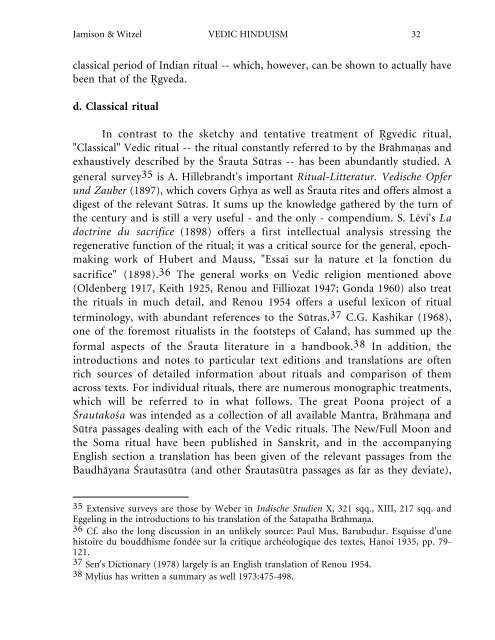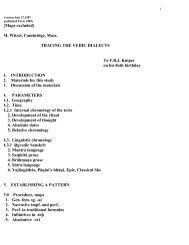VEDIC HINDUISM by S. W. Jamison and M. Witzel - people.fas ...
VEDIC HINDUISM by S. W. Jamison and M. Witzel - people.fas ...
VEDIC HINDUISM by S. W. Jamison and M. Witzel - people.fas ...
You also want an ePaper? Increase the reach of your titles
YUMPU automatically turns print PDFs into web optimized ePapers that Google loves.
<strong>Jamison</strong> & <strong>Witzel</strong> <strong>VEDIC</strong> <strong>HINDUISM</strong> 32<br />
classical period of Indian ritual -- which, however, can be shown to actually have<br />
been that of the �gveda.<br />
d. Classical ritual<br />
In contrast to the sketchy <strong>and</strong> tentative treatment of �gvedic ritual,<br />
"Classical" Vedic ritual -- the ritual constantly referred to <strong>by</strong> the Bråhma�as <strong>and</strong><br />
exhaustively described <strong>by</strong> the Śrauta Sūtras -- has been abundantly studied. A<br />
general survey35 is A. Hillebr<strong>and</strong>t's important Ritual-Litteratur. Vedische Opfer<br />
und Zauber (1897), which covers G�hya as well as Śrauta rites <strong>and</strong> offers almost a<br />
digest of the relevant Sūtras. It sums up the knowledge gathered <strong>by</strong> the turn of<br />
the century <strong>and</strong> is still a very useful - <strong>and</strong> the only - compendium. S. Lévi's La<br />
doctrine du sacrifice (1898) offers a first intellectual analysis stressing the<br />
regenerative function of the ritual; it was a critical source for the general, epochmaking<br />
work of Hubert <strong>and</strong> Mauss, "Essai sur la nature et la fonction du<br />
sacrifice" (1898).36 The general works on Vedic religion mentioned above<br />
(Oldenberg 1917, Keith 1925, Renou <strong>and</strong> Filliozat 1947; Gonda 1960) also treat<br />
the rituals in much detail, <strong>and</strong> Renou 1954 offers a useful lexicon of ritual<br />
terminology, with abundant references to the Sūtras.37 C.G. Kashikar (1968),<br />
one of the foremost ritualists in the footsteps of Cal<strong>and</strong>, has summed up the<br />
formal aspects of the Śrauta literature in a h<strong>and</strong>book.38 In addition, the<br />
introductions <strong>and</strong> notes to particular text editions <strong>and</strong> translations are often<br />
rich sources of detailed information about rituals <strong>and</strong> comparison of them<br />
across texts. For individual rituals, there are numerous monographic treatments,<br />
which will be referred to in what follows. The great Poona project of a<br />
Śrautakośa was intended as a collection of all available Mantra, Bråhma�a <strong>and</strong><br />
Sūtra passages dealing with each of the Vedic rituals. The New/Full Moon <strong>and</strong><br />
the Soma ritual have been published in Sanskrit, <strong>and</strong> in the accompanying<br />
English section a translation has been given of the relevant passages from the<br />
Baudhåyana Śrautasūtra (<strong>and</strong> other Śrautasūtra passages as far as they deviate),<br />
35 Extensive surveys are those <strong>by</strong> Weber in Indische Studien X, 321 sqq., XIII, 217 sqq. <strong>and</strong><br />
Eggeling in the introductions to his translation of the Śatapatha Bråhma�a.<br />
36 Cf. also the long discussion in an unlikely source: Paul Mus, Barubu�ur. Esquisse d'une<br />
histoire du bouddhisme fondée sur la critique archéologique des textes, Hanoi 1935, pp. 79-<br />
121.<br />
37 Sen's Dictionary (1978) largely is an English translation of Renou 1954.<br />
38 Mylius has written a summary as well 1973:475-498.

















